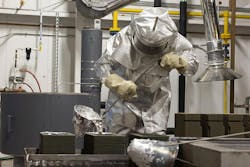USAF Workshop Adds 3DP Mold Making
The Reverse Engineering and Critical Tooling (REACT) Lab at Tinker Air Force Base in central Oklahoma is casting aluminum aircraft parts, using 3D printing to manufacture sand molds. The workshop melts aluminum ingots and pours parts weighing up to 120 pounds, which are then milled to required surface finishes.
REACT Lap is operated by the U.S. Air Force 76th Commodities Maintenance Group. Additive manufacturing (3D sand printing) is a new resource available to the lab to produce replacement parts for components that may not be available from original manufacturers or via suppliers’ RFQ bidding.
Some parts the Lab is able to mold and cast now include bearing housings, fuel fittings, and other components for propulsion, avionics and control systems.
“Three-dimensional sand printing is yet another technology that the REACT Lab has added to their manufacturing base in the last two years,” stated Ryan Fowler, REACT materials engineer. “We are working towards getting metal-printed components certified as airworthy, but since it’s a new technology it takes quite a bit more effort.”
Currently, the sand castings are quality-rated as “Grade B”, though Grade A parts are the goal.
Although none of the castings produced there are certified for installation on aircraft as yet, Michael Thompson, 76th CMXG foundry process engineer, expects the products to achieve airworthiness standards in the future. Preliminary work is underway for the operation to gain National Aerospace and Defense Contractors Accreditation Program (NADCAP) certification in June 2024.
The 76th CMXG is directs, manages, and operates depot-level maintenance for repair and overhaul of U.S. Air Force, U.S. Navy, and Foreign Military Service aircraft and engine parts. “Designing molds and pouring parts in-house allows us to keep our aircraft flying,” according to Thompson. “We cannot let the lack of a $100 casting ground a $50 million aircraft.”
Planned future investments include a mold pre-heating unit, to improve sand-process control and allow the foundry to produce higher-quality castings.
An automated investment casting cell is foreseen too, to produce wax molds for shell casting of near-net-shape parts with higher-quality finishes.
